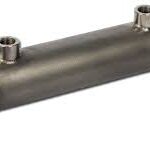Dry Cooler
Dry Cooler is a type of heat exchanger that uses ambient air to cool a fluid, typically water or a water-glycol mixture, without evaporating the fluid. It operates on the principle of sensible heat transfer, where the heat from the fluid is transferred to the air passing over the finned tubes of the cooler. Dry coolers are commonly used in HVAC systems, industrial processes, and data centers for cooling purposes. They are energy-efficient, environmentally friendly, and do not consume water, making them suitable for applications where water conservation is important.

Dry Cooler
Operation of
- Heat Exchanger Coils:
- Function: The fluid to be cooled flows through these coils, transferring its heat to the coil walls. The fins attached to the coils enhance the heat dissipation by increasing the contact area with the air.
- Fans:
- Function: Move ambient air across the heat exchanger coils. Axial fans are typically used for high-volume, low-pressure applications, while centrifugal fans are used for low-volume, high-pressure applications.
- Control Systems:
- Temperature Sensors: Measure the temperature of the fluid and ambient air to control the operation of the fans.
- Variable Speed Drives (VSD): Adjust the fan speed to match the cooling demand, enhancing energy efficiency.
Dry Cooler
Modes of Operation in
- Constant Speed Operation:
- Fans run at a constant speed regardless of the cooling demand. This mode is simpler but less energy-efficient as it does not adjust to varying loads.
- Variable Speed Operation:
- Fans are equipped with VSDs to adjust their speed based on the cooling demand. This mode is more energy-efficient, as it reduces power consumption during periods of low demand.
- On/Off Control:
- Fans are turned on or off based on temperature setpoints. When the fluid temperature exceeds a setpoint, the fans are activated; they turn off when the temperature drops below the setpoint.
Dry Cooler
Application of
- Cooling commercial and residential buildings.
- Reducing water usage and maintenance compared to traditional cooling towers.
- Managing heat loads from servers and electronic equipment.
- Ensuring reliable performance and preventing overheating.
- Cooling working fluids in solar thermal and geothermal power plants.
- Supporting sustainable energy production with reduced water consumption.
- Cooling engine coolant and hydraulic fluids in test facilities and production lines.
- Preventing overheating of critical components.
Dry Cooler
Types of
Other Heat Exchangers We Manufacturer
Stainless Steel Heat Exchanger
Stainless Steel Heat Exchangers are devices that use stainless steel as the primary material for transferring heat between fluids. They are valued for their corrosion resistance, durability in high temperatures and pressures

Copper Heat Exchangers
Copper Heat Exchangers are devices designed to efficiently transfer heat between two fluids or between a fluid and a solid surface. They utilize copper, a highly conductive metal known for its excellent thermal properties.

Marine Heat Exchanger
Marine Heat Exchangers are essential for cooling engines, generators, and onboard equipment using seawater or freshwater. Made from corrosion-resistant materials like titanium or cupronickel

Boiler Coils
Boiler coils are heat exchangers made of metal tubes arranged in a coil pattern, used in boiler systems to transfer heat from combustion gases to water or steam. They are typically made from heat-resistant materials

Tube in Tube Heat Exchanger
Tube in Tube Heat Exchangers consists of two concentric tubes where one fluid flows through the inner tube and another fluid flows through the annular space between the inner and outer tubes.

